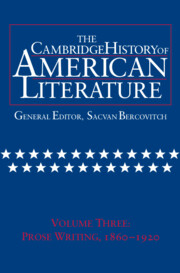Book contents
- Frontmatter
- Introduction
- THE AMERICAN LITERARY FIELD, 1860–1890
- LITERARY FORMS AND MASS CULTURE, 1870–1920
- PROMISES OF AMERICAN LIFE, 1880–1920
- BECOMING MULTICULTURAL: CULTURE, ECONOMY, AND THE NOVEL, 1860–1920
- 1 Introduction
- 2 Remembering civil war
- 3 Social death and the reconstruction of slavery
- 4 Cosmopolitan variations
- 5 Native-American sacrifice in an age of progress
- 6 Marketing culture
- 7 Varieties of work
- 8 Corporate America
- 9 Realist utopias
- Chronology 1860–1920
- Bibliography
- Index
1 - Introduction
from BECOMING MULTICULTURAL: CULTURE, ECONOMY, AND THE NOVEL, 1860–1920
Published online by Cambridge University Press: 28 March 2008
- Frontmatter
- Introduction
- THE AMERICAN LITERARY FIELD, 1860–1890
- LITERARY FORMS AND MASS CULTURE, 1870–1920
- PROMISES OF AMERICAN LIFE, 1880–1920
- BECOMING MULTICULTURAL: CULTURE, ECONOMY, AND THE NOVEL, 1860–1920
- 1 Introduction
- 2 Remembering civil war
- 3 Social death and the reconstruction of slavery
- 4 Cosmopolitan variations
- 5 Native-American sacrifice in an age of progress
- 6 Marketing culture
- 7 Varieties of work
- 8 Corporate America
- 9 Realist utopias
- Chronology 1860–1920
- Bibliography
- Index
Summary
The title of my narrative registers the novel's grounding in a broad spectrum of cultural and economic developments. These include: the end of slavery; the intensification of foreign immigration; the labor unrest catalyzed by the expansion of industrial capitalism; the revolution in transportation and communication; the rise of mass production and distribution; the process of standardization and professionalization; the emergence of the corporation and with it of “corporate culture”; and the dramatic extension of media forms, among them, newspapers, magazines, and advertising. Of these historical developments, none is more significant than the growing awareness of American multiculturalism. This country has “always already” been multicultural. Yet not until the second half of the nineteenth century were the specific stakes of this diversity widely conceptualized and debated. Novels of the time provided a critical forum for these conceptualizations and debates. Sometimes they did so through a focus on the death industries of slavery and war; sometimes through a concern with the work of mourning for a lost culture; sometimes through descriptions of the inner workings of new business enterprises such as magazines or clothing manufacture, or through pleas for industrial reform. Cross-cultural comparison was a mainstay of social observation not only in notoriously heterogeneous urban settings, but in towns and rural areas as well. This was the era of America's self-consciousness about its extraordinary diversity – the era, that is, of its multicultural becoming – and rising rates of immigration and growing perceptions of the world's interconnectedness served as a daily assault on the forces of parochialism.
- Type
- Chapter
- Information
- The Cambridge History of American Literature , pp. 411 - 420Publisher: Cambridge University PressPrint publication year: 2005

